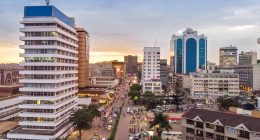Construction and Sustainable Development should be joined to the hip. The January 2016 World Economic Forum held in Davos reinforced the new digital economy as the fourth industrial revolution that will see efficient resource utilization through automations. The 2015 Paris Agreement on Climate Change also set out a global action plan to mitigate risks of global warming and climate change. The United Nations under its 2030 Agenda for Sustainable Development Goals has also set clear targets on sustainable cities and communities. Organizations (including construction industry firms) around the world, and their stakeholders, are becoming increasingly aware of the need for, and benefits of, environmentally responsible behaviour. An organisation’s performance in relation to the society in which it operates and to its impact on the environment has become a critical part of measuring its overall performance, and its ability to continue operating effectively.
“Swamps that ought to be the filters of city and urban waste have instead turned into mini-factories for construction materials like bricks, blocks, concrete products etc.”
This is, in part, a reflection of the growing recognition of the need for ensuring healthy ecosystems, social equity, and good organisational governance. Green building (also known as green construction or sustainable building) refers to both a structure and the using of processes that are environmentally responsible and resource- efficient throughout a building’s life-cycle: from siting to design, construction, operation, maintenance, renovation, and demolition. The sourcing and production of the bulk of the construction materials e.g. sand, stones, bricks, timber that are utilized in Uganda and Africa at large, is done wetlands, natural forests and delicate ecosystems both in rural and urban areas. Swamps that ought to be the filters of city and urban waste have instead turned into mini-factories for construction materials like bricks, blocks, concrete products etc.
The natural forests that are integral to the water cycle/ rain formation have not been spared by the demand for timber and tree poles in the construction industry. As stakeholders in the construction industry, we need to explore opportunities and innovative approaches for adopting green building technologies to ensure environment safety and sustainable development.
Mapping and Quantifying Resource Utilization
It is important to use a structured approach to measure and map resource consumption, waste generation and other impacts on the environment. Construction industry players (construction firms, contractors, manufacturers, consultants etc.) need to start mapping and quantifying their resource utilization e.g. water and energy consumption.
It is Management consultant Peter Drucker who said “If you can’t measure it, you can’t manage it.” And this does indeed apply to construction industry and green building too! For example, how much energy is consumed in producing a cubic meter of concrete or how much water is used in producing (in a factory) a tonne of steel or a tonne of cement? It is on this premise that we can explore how manufacturers and building firms in the industry can explore opportunities for leaner production technologies Green building concepts require organizations to assess their processes, projects, products, and equipment in order to identify and implement strategies to increase efficiencies, prevent pollution, and reduce waste at source and to minimise risks to humans and the environment.
Life Cycle Costing
It is well known truism that construction projects and buildings in particular ought to be delivered within budget, so as to earn healthy returns on investment during their operation and maintenance. Firms in the construction industry, as part of the green building initiative, should also embrace the Life Cycle Costing concept for all infrastructure projects. Life Cycle Costing is a technique used to establish the total cost of ownership of a product or service incurred throughout its whole life. Buildings and many other projects in the construction industry usually have design lives in excess of 50 years! Green building concept requires us to internalise all the environmental costs associated with a project based on life cycle costing rather than only the direct cost of the building or project at the point of acquisition or construction or investment. Life cycle costs include: project costs incurred during construction, operational costs incurred during the operational life of the building that may increase with time. For buildings/ city skyscrapers, these operational costs may include heating, lighting, running elevators, floor and building repairs etc. For public infrastructure like roads, bridges and dams, the maintenance and repair costs tend to be high.
This calls for innovate approaches to developing infrastructure projects that will not only be structurally sound, but shall also be sustainable to offer public services through their design life. Life cycle costing for green building would also include the “end of life” costs associated with the disposal of wastes generated from the assets and infrastructure during both the project construction phase and the operating and maintenance phase. The construction industry generates a lot of waste, whose costs of management should be factored in the costs for the construction phase and during operation and maintenance too! Corporate Social Investments that optimize the utilization of resources. Construction firms could engage in partnerships with communities and commercial farmers for initiatives that support green building concepts, as part of their corporate social investment. For example if for every 1,000 cubic meters of sand mined or 100 tons of timber consumed by a large construction firm for a building project in Kampala city, it provided 1,000 waste bins to help in waste management in city markets or shopping, they would be helping in the segregation and sorting of waste to explore possibilities for waste re-use and recycling.
The use of better waste management techniques in city buildings goes a long way in helping shape mindsets and processes towards operating and maintaining these buildings as green buildings with minimal carbon footprint on the environment. Construction industry player could also explore supporting agro forestry especially in rural communities, which unfortunately do suffer the brunt of global warming and climate change. The effects on our economy and continent from greenhouse gas emissions and other forms of pollution and resource depletion are becoming increasingly clear. The rising costs of energy, water and raw materials, increasing environmental regulation, and a growing customer awareness and demand for green building processes and products, are on the rise. By going green, construction firms can not only survive, but also thrive in this new economic and environmental climate. The new competitive advantage will be and, in many cases already is, ‘eco-advantage’ or green business.
The writer is a Civil Engineer working with Isimba Hydro Power Project
Twitter: @RugabaAgaba







